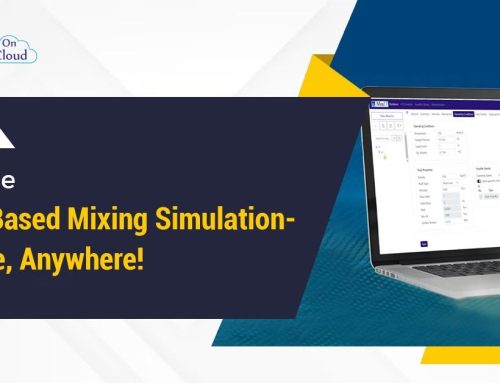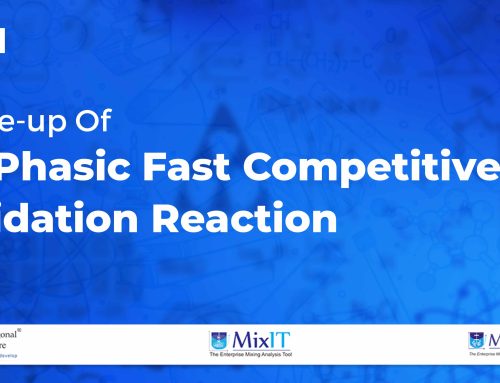Improve Product Yields Via Better Micromixing
Mothivel Mummudi, Principal Engineer.
San Antonio, TX, USA, August 25th, 2015
Turbulence is practically everywhere and is a naturally occurring phenomenon. It is characterized by random/stochastic variations in velocity, pressure, species concentrations etc. Industrial reactors employ flows that are sometimes highly turbulent – largely because of the better mixing achievable with turbulence.
However, one does wonder ….
a) Does ensuring a high degree of turbulence in the reaction vessel automatically guarantee a good product?
b) In typical reactors which employ complex reactions, does good stirring always result in good yield and selectivity?
The answer to both questions – it turns out, is “not always – it kinda depends” ….
Here is why …
In general, turbulent mixing occurs across a range of length scales. Mixing at large scales, i.e., visible to the naked eye is called macromixing. This is the kind of mixing that is directly benefited by better design of agitators and static mixers.
There is of course mixing that occurs at smaller scales (all the way to the molecular level) – this is termed “micromixing”. This mixing is only indirectly influenced by impeller design etc. Good micromixing is said to occur when the reactants are mixed quite well even at the molecular level. Typically, micromixing is an aspect of importance when feed pipes with small diameters feed into large diameter reaction vessels.
For good selectivity and yield in reaction vessels the reactants need to be mixed at the molecular level (chemical reactions are molecular phenomena!).
So however good the macromixing may be – your reactors will not perform well unless the design ensures good micromixing as well !
Understanding the quality of micromixing in the reaction vessel is therefore key to improving the product selectivity to desirable levels.
So how does one go about doing this ?
There are a number of experimental methods that have been devised to determine the quality of micromixing – many of them are labor-intensive and some of them can be expensive.
A more efficient way to analyze micromixing in reactors is to use computational fluid dynamics (CFD) tools. Micromixing is strongly coupled to local flow conditions in a reaction vessel. CFD models enable a thorough understanding of flow, thereby allowing for a good quantification of micromixing. Using CFD models, many industrially important reaction systems (and reactors) – polymerization, alkoxylation, bioprocesses etc can be effectively studied. Results from a typical CFD analysis of micromixing can be used to design processes with better yield, scale up with more confidence and operate with more reliability. In many such cases, CFD analysis can be used to design mixing elements that allow for better micromixing of reactant from small diameter feed-pipes into large diameter vessels. In other situations, a CFD analysis can drive better location and sizing of the feed pipe. In confined impinging jet reactors (CIJRs), for example, the location of the jet nozzles can be optimized for better yield based on a CFD analysis.
Tridiagonal Solutions Inc has many years of combined experience in analyzing mixing (across length scales) in industrial reactors. We have helped our partners in the chemicals (petro, specialty, consumer and fine), food and pharmaceutical industry improve their product yield and selectivity – by enabling a better understanding of their reactors.
So the next time you start thinking about getting a better agitator to improve your product yield – think again.
It may be that feed pipe that needs redesign.
To know more about micromixing, send us an email at marketing@tridiagonal.com
About MixIT
MixIT, a comprehensive, easy-to-use enterprise analysis software designed to predict stirred tank mixing performance, with a unique capability of automated CFD analysis. MixIT enables enterprises to design, compare, scale-up (plant to lab scale) and analyze the performance of multiple stirred tank reactors and bioreactors, by using standard correlations and advanced CFD models.
About Tridiagonal Solutions Inc
Tridiagonal Solutions Inc is an advanced engineering solutions provider with expertise in process performance enhancement and product development solutions for industrial clients worldwide. Their portfolio includes process engineering, CFD, EFD, Discrete Element Modeling services and chemical mixing simulation products . Tridiagonal Solutions caters to the Chemical and Process, Oil and Gas, Consumer goods, Food, Electronics, Power Generation and Healthcare Industries. For more information please visit www.tridiagonal.com or call (210) 858-6192.
Tridiagonal Solutions Inc | 12703 Spectrum Drive | San Antonio | TX 78249 | USA
newsletter-mixit@Tridiagonal.com
Reference Links:









Leave A Comment